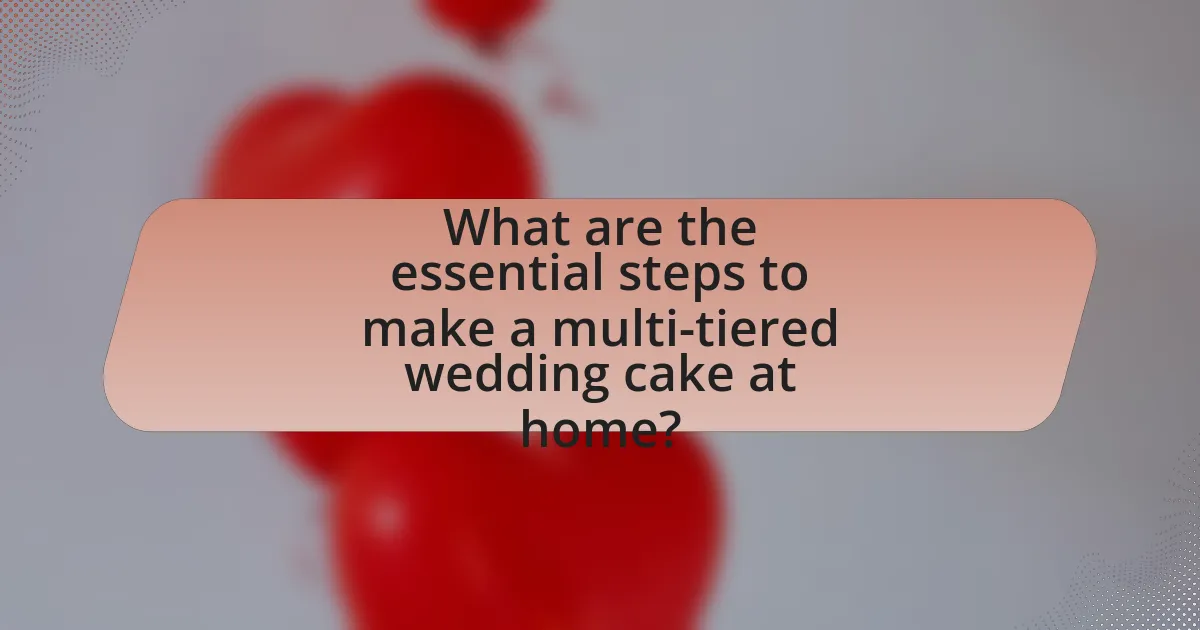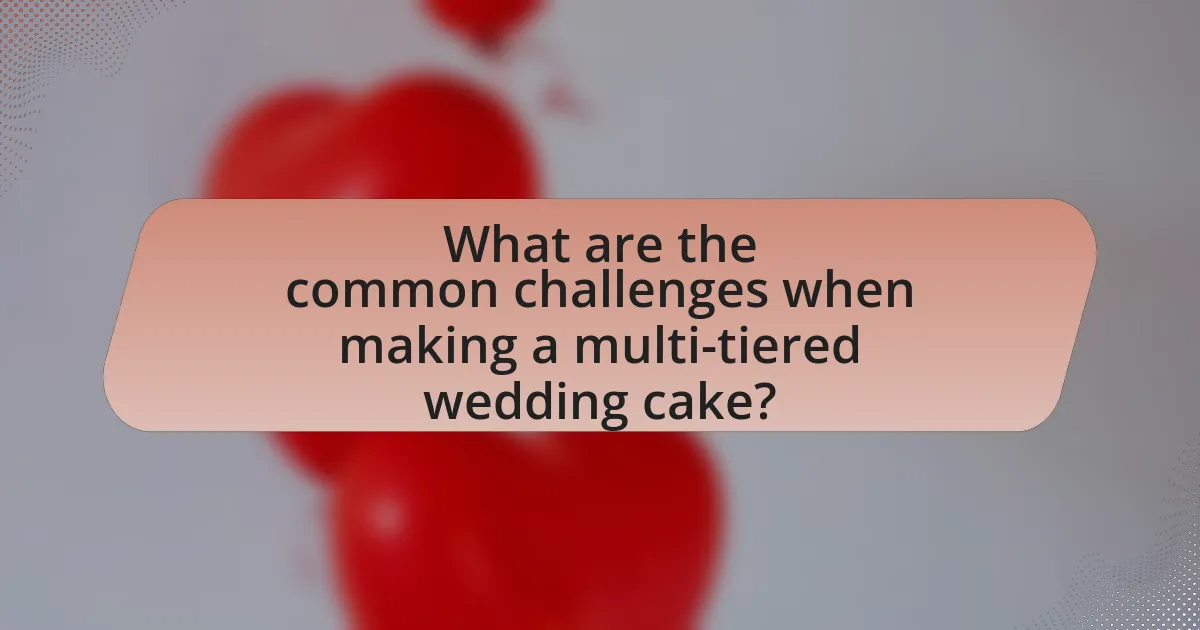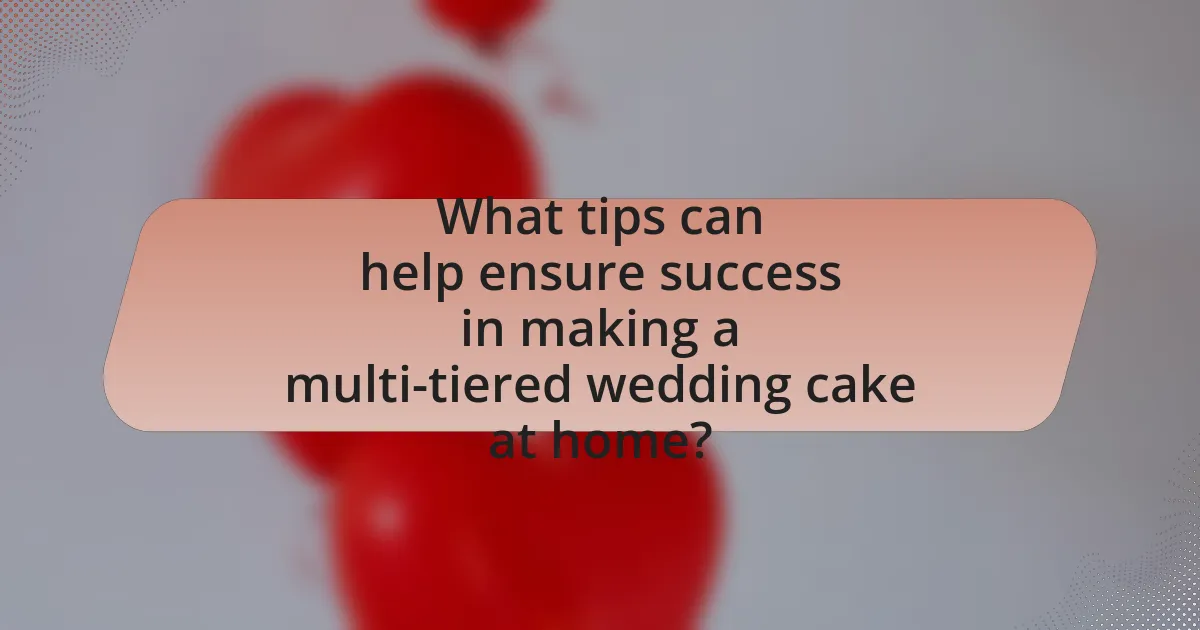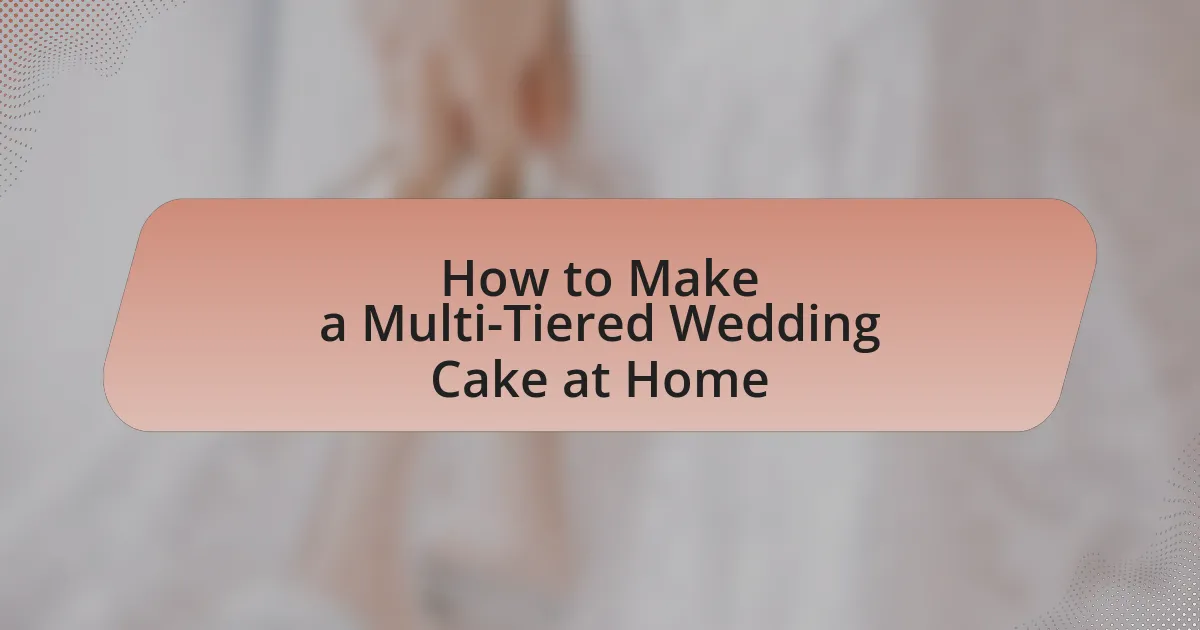The article provides a comprehensive guide on how to make a multi-tiered wedding cake at home, detailing essential steps from preparation to decoration. It covers the necessary ingredients, tools, and baking techniques required for successful cake construction, emphasizing the importance of structural stability and even baking. Additionally, the article addresses common challenges faced during the baking and decorating processes, offering troubleshooting tips and best practices to ensure a visually appealing and stable cake. Overall, it serves as a practical resource for home bakers looking to create an impressive multi-tiered wedding cake.

What are the essential steps to make a multi-tiered wedding cake at home?
To make a multi-tiered wedding cake at home, follow these essential steps: First, prepare the cake batter by selecting your desired flavors and baking them in different-sized cake pans. After baking, allow the cakes to cool completely. Next, level the cakes by trimming the tops to ensure even stacking. Then, apply a layer of frosting on each cake layer to act as glue when stacking.
Once frosted, stack the layers starting from the largest at the bottom to the smallest at the top, using dowels for support in the larger tiers to prevent collapsing. After stacking, cover the entire cake with a final layer of frosting and decorate as desired. Finally, refrigerate the cake to set the frosting before serving. These steps ensure a stable and visually appealing multi-tiered wedding cake.
How do you prepare for baking a multi-tiered wedding cake?
To prepare for baking a multi-tiered wedding cake, gather all necessary ingredients and tools, including cake pans, mixers, and decorating supplies. Start by selecting a cake recipe that can support multiple tiers, such as a denser cake like pound cake or a butter cake, which are known for their structural integrity. Measure and prepare ingredients accurately, as precision is crucial in baking. Preheat the oven to the required temperature and ensure that the cake pans are greased and lined with parchment paper to prevent sticking. Additionally, create a timeline for baking, cooling, and decorating to manage the process efficiently, as multi-tiered cakes require careful planning to ensure each layer is baked and assembled correctly.
What ingredients are needed for a multi-tiered wedding cake?
A multi-tiered wedding cake typically requires flour, sugar, eggs, butter, baking powder, milk, and vanilla extract for the cake layers. Additionally, fondant or buttercream is needed for frosting and decorating the tiers. These ingredients are essential for creating a stable and visually appealing cake structure, as they contribute to the cake’s flavor, texture, and overall design.
What tools and equipment are essential for this baking project?
Essential tools and equipment for making a multi-tiered wedding cake at home include a stand mixer, measuring cups and spoons, mixing bowls, baking pans of various sizes, a cooling rack, a cake leveler, a spatula, and a cake decorating kit. The stand mixer is crucial for achieving the right batter consistency, while measuring cups and spoons ensure accurate ingredient proportions. Mixing bowls are necessary for combining ingredients, and baking pans in different sizes allow for tiered cake construction. A cooling rack helps cakes cool evenly, and a cake leveler ensures uniform layers. Finally, a cake decorating kit provides the tools needed for finishing touches, such as icing and decorations.
What are the key baking techniques for a multi-tiered wedding cake?
The key baking techniques for a multi-tiered wedding cake include proper leveling, stacking, and supporting the tiers. Leveling ensures each cake layer is flat, which is crucial for stability and aesthetics. Stacking involves carefully placing each tier on top of the other, often using dowels or cake boards for support, which prevents the cake from collapsing under its own weight. Supporting the tiers with dowels or straws distributes the weight evenly and maintains structural integrity. These techniques are essential for achieving a visually appealing and stable multi-tiered cake, as evidenced by professional baking standards that emphasize the importance of these methods in cake construction.
How do you bake the cake layers evenly?
To bake cake layers evenly, ensure that the oven is preheated to the correct temperature and use the same size pans for each layer. Additionally, fill each pan with an equal amount of batter, typically two-thirds full, to promote uniform rising. Using an oven thermometer can verify the temperature accuracy, as uneven heat can lead to uneven baking. Rotating the pans halfway through the baking time also helps achieve even layers by allowing for consistent heat distribution.
What methods can be used to ensure the cake layers are moist?
To ensure cake layers are moist, bakers can incorporate ingredients like buttermilk, yogurt, or sour cream, which add moisture and richness. These dairy products contain acids that tenderize the gluten in the flour, resulting in a softer texture. Additionally, using oil instead of butter can enhance moisture retention, as oil remains liquid at room temperature, keeping the cake moist longer. Another effective method is to brush the baked layers with simple syrup, a mixture of equal parts sugar and water, which adds sweetness and moisture after baking. Finally, wrapping the layers tightly in plastic wrap while they cool helps to trap steam, preventing dryness.
How do you assemble a multi-tiered wedding cake?
To assemble a multi-tiered wedding cake, start by stacking the tiers on a sturdy base, ensuring each layer is level and supported. Use dowels or cake supports in the lower tiers to prevent collapsing under the weight of the upper layers. Place the largest tier at the bottom, followed by progressively smaller tiers, and secure each layer with frosting or a thin layer of ganache to help them adhere. This method is validated by professional cake decorators who emphasize the importance of structural integrity in multi-tiered cakes to avoid collapse during transport and display.
What is the best way to stack the cake layers securely?
The best way to stack cake layers securely is to use dowels or cake supports to provide stability. Dowels should be inserted into the bottom layer to support the weight of the layers above, ensuring that the cake does not collapse. Additionally, placing a cardboard cake round under each layer can help distribute weight evenly and prevent shifting. This method is widely recommended by professional bakers, as it maintains the structural integrity of multi-tiered cakes during transport and display.
How do you apply frosting and decorations effectively?
To apply frosting and decorations effectively, start by ensuring the cake layers are completely cooled and leveled. Use a spatula or a piping bag to spread an even layer of frosting on the top and sides of the cake, smoothing it out for a clean finish. For decorations, consider using fondant, edible flowers, or piping techniques to enhance the visual appeal. The use of a turntable can aid in achieving a uniform application. According to baking experts, a well-frosted cake not only looks professional but also enhances the overall taste experience, as the frosting complements the cake’s flavor.

What are the common challenges when making a multi-tiered wedding cake?
Common challenges when making a multi-tiered wedding cake include structural stability, weight distribution, and temperature control. Structural stability is crucial because each tier must support the weight of the tiers above it; inadequate support can lead to collapse. Weight distribution is also a challenge, as heavier tiers can cause the lower tiers to compress or deform. Additionally, temperature control is vital during baking and decorating, as fluctuations can affect the cake’s texture and icing consistency. These challenges require careful planning and execution to ensure a successful multi-tiered wedding cake.
What issues might arise during the baking process?
Issues that might arise during the baking process include uneven baking, ingredient measurement errors, and temperature fluctuations. Uneven baking can occur if the oven is not calibrated correctly or if the batter is not evenly distributed in the pans, leading to some layers being overcooked while others remain undercooked. Ingredient measurement errors, such as using too much flour or not enough sugar, can affect the cake’s texture and flavor, resulting in a dense or overly sweet product. Temperature fluctuations, whether from opening the oven door too frequently or placing the cake in a drafty area, can cause the cake to collapse or not rise properly. These issues can significantly impact the final outcome of a multi-tiered wedding cake, making attention to detail crucial during the baking process.
How can you prevent cake layers from collapsing?
To prevent cake layers from collapsing, ensure that the cake is fully cooled before stacking. Cooling allows the structure to set, reducing the risk of sagging. Additionally, use a sturdy cake recipe that includes sufficient flour and eggs, as these ingredients provide stability. Incorporating a support system, such as dowels or cake boards, can also help distribute weight evenly among layers, preventing collapse. Properly leveling each layer before stacking ensures a flat surface, which further enhances stability.
What should you do if the cake layers are uneven?
If the cake layers are uneven, you should level them using a serrated knife or a cake leveler. This technique involves placing the cake on a flat surface, holding the knife horizontally, and carefully slicing off the domed top of each layer to create a flat surface. Leveling is essential for stability in multi-tiered cakes, as uneven layers can lead to structural issues and an unappealing appearance. Proper leveling ensures that each layer sits evenly, which is crucial for the overall aesthetic and integrity of the cake.
What are the decorating challenges for a multi-tiered wedding cake?
Decorating a multi-tiered wedding cake presents several challenges, including structural stability, even icing application, and design coherence across tiers. Structural stability is crucial because each tier must support the weight of the tiers above it, requiring proper doweling and support systems to prevent collapse. Even icing application is challenging due to the varying sizes and shapes of tiers, which can lead to uneven surfaces if not managed carefully. Additionally, achieving design coherence is essential; the decorations must flow seamlessly from one tier to another, which can be difficult when using different techniques or colors. These challenges necessitate careful planning and execution to ensure a visually appealing and structurally sound cake.
How do you achieve a smooth frosting finish?
To achieve a smooth frosting finish, apply a crumb coat first, which is a thin layer of frosting that seals in crumbs. After chilling the cake to set the crumb coat, use a spatula or bench scraper to apply a thicker layer of frosting, smoothing it out with gentle, even strokes. The use of a heated spatula can further enhance the smoothness by melting the frosting slightly as you spread it. This method is validated by professional bakers who emphasize the importance of temperature control and technique in achieving a flawless finish.
What techniques can be used for intricate decorations?
Techniques for intricate decorations on a multi-tiered wedding cake include piping, fondant work, and sugar crafting. Piping involves using a pastry bag to create detailed designs, such as lace patterns or floral motifs, which can enhance the cake’s elegance. Fondant work allows for smooth finishes and the creation of intricate shapes, such as flowers or figurines, that can be placed on the cake. Sugar crafting involves molding sugar into decorative elements, providing a three-dimensional aspect to the design. These techniques are widely used in professional cake decorating, as evidenced by their prevalence in culinary competitions and cake design classes.

What tips can help ensure success in making a multi-tiered wedding cake at home?
To ensure success in making a multi-tiered wedding cake at home, it is essential to plan and prepare thoroughly. Begin by selecting a reliable recipe that provides clear instructions and accurate measurements for each tier. Use high-quality ingredients, as they significantly impact the cake’s flavor and texture.
Additionally, bake each tier separately to ensure even cooking and avoid collapsing layers. Allow the cakes to cool completely before frosting, as this prevents melting and sliding. When assembling, use dowels or supports to stabilize the tiers, distributing weight evenly to prevent structural failure.
Finally, practice your decorating skills beforehand to achieve a polished finish, and consider refrigerating the cake to set the frosting before serving. These steps are supported by baking experts who emphasize the importance of preparation and structural integrity in multi-tiered cakes.
How can you plan your baking schedule effectively?
To plan your baking schedule effectively for a multi-tiered wedding cake, start by creating a timeline that outlines each step of the baking process, including preparation, baking, cooling, and decorating. This timeline should account for the complexity of each tier and the total number of tiers, ensuring that you allocate sufficient time for each task. For example, if a tier requires a specific cooling time of at least two hours before decorating, this must be factored into your overall schedule. Additionally, consider baking the tiers in advance and freezing them, as cakes can be stored in the freezer for up to three months without losing quality, allowing for a more relaxed final preparation day.
What is the ideal timeline for baking and decorating?
The ideal timeline for baking and decorating a multi-tiered wedding cake is approximately three days. On the first day, bake the cake layers and allow them to cool completely. The second day should be dedicated to leveling, filling, and stacking the layers, followed by applying a crumb coat. The final day is reserved for decorating the cake with fondant, buttercream, or other embellishments. This timeline ensures that each step is completed thoroughly, allowing for proper cooling and setting, which is crucial for a stable and visually appealing cake.
How can you manage your time on the day of the event?
To manage your time on the day of the event, create a detailed schedule that outlines each task and its duration. This schedule should include specific time slots for baking, cooling, assembling, and decorating the multi-tiered wedding cake. For instance, allocate three hours for baking the cake layers, one hour for cooling, and two hours for assembly and decoration. By adhering to this structured timeline, you can ensure that each step is completed efficiently, minimizing the risk of delays. Time management is crucial in baking, as the cake must be fully cooled before decorating; thus, planning allows for a smooth workflow and timely completion of the cake.
What are some best practices for troubleshooting common issues?
Best practices for troubleshooting common issues when making a multi-tiered wedding cake include checking oven temperature accuracy, ensuring proper ingredient measurements, and assessing structural stability. Accurate oven temperatures are crucial; using an oven thermometer can confirm that the heat is consistent, preventing undercooked or overcooked layers. Precise measurements of ingredients, particularly flour and sugar, are essential for achieving the right texture and flavor; using a kitchen scale can enhance accuracy. Additionally, ensuring that each tier is adequately supported with dowels or cake boards prevents collapsing, which is critical for maintaining the cake’s integrity during assembly and transport.
How do you fix a cake that has sunk in the middle?
To fix a cake that has sunk in the middle, you can level the cake by cutting off the sunken part and filling it with frosting or a similar mixture. This method allows for a more even surface, which is essential for stacking layers in a multi-tiered wedding cake. Additionally, ensuring proper baking techniques, such as not opening the oven door too early and using the correct oven temperature, can prevent sinking in future cakes.
What should you do if the frosting is too runny?
To fix runny frosting, add powdered sugar gradually until the desired consistency is achieved. This method works because powdered sugar thickens the frosting without altering its flavor significantly. Typically, adding about one tablespoon at a time allows for better control over the texture, ensuring the frosting can hold its shape when applied to a multi-tiered wedding cake.
